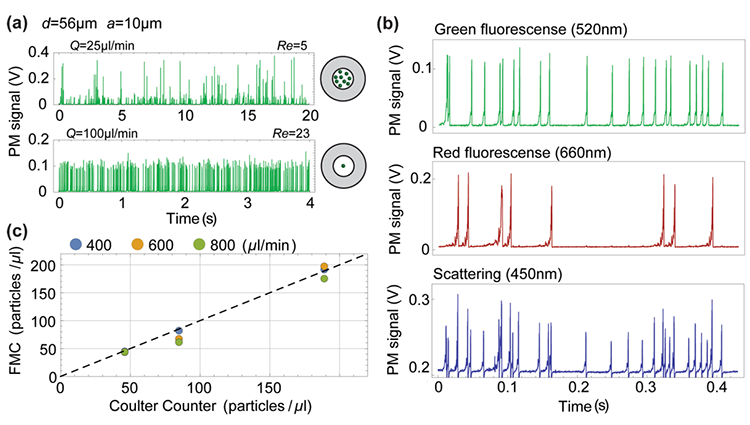Membrane proteins constitute one of the largest and most important classes of proteins. Membrane proteins play critical roles in various biological processes and can function as ion channels, transporters, receptors, and so on. A significant portion of membrane proteins, especially transporters and receptors, are considered targets for drugs. By far, more than 60% of FDA-approved antibody therapies target membrane proteins, which has attracted an immense attention in the pharmaceutical industry. Despite of their essential roles in both industrial and academic researches, the isolation and characterizations of membrane proteins can be very challenging, not only due to their insolubility nature, but also because they often fold into conformationally complex structures that are difficult to retain outside of the cell.
Profacgen provides a highly sensitive high-throughput method for the screening of drug candidates against membrane proteins. Specifically, full-length membrane proteins which are individually expressed in human cells are used as ‘baits’ for a specific molecule to be tested. Binding of membrane protein to its target is subsequently confirmed by flow cytometry (Figure 1). As the binding events are characterized in unfixed cells, where membrane protein retain their structural integrity, the subsequent result can reflect the protein-target binding in native-status cells.
 Figure 1. Flow cytometer characterization. (a) Detection of 10-µm fluorescent particles in a 56-µm diameter capillary. Photomultiplier (PM) signal for (top) unfocused particles flowing at 25 µl/min, and (bottom) focused particles flowing at 100 µl/min; (b) Detection of scattering and fluorescence from a mixture of green and red 10-µm labelled particles. Green, red and blue traces represent green fluorescence centred at 508 nm, red fluorescence centred at 658 nm, and scattering at 450 nm, respectively. A total of 8003 green and 2210 red fluorescence particles are detected in 2 minutes, while the scattering events are 10113; (c) Comparison between number of particles measured by the fbre micro flow cytometer (FMC) and by Coulter counter for flow rates of 400, 600 and 800 µl/min and three different concentrations. 15-µm particles are focused in a 90-µm capillary.
Figure 1. Flow cytometer characterization. (a) Detection of 10-µm fluorescent particles in a 56-µm diameter capillary. Photomultiplier (PM) signal for (top) unfocused particles flowing at 25 µl/min, and (bottom) focused particles flowing at 100 µl/min; (b) Detection of scattering and fluorescence from a mixture of green and red 10-µm labelled particles. Green, red and blue traces represent green fluorescence centred at 508 nm, red fluorescence centred at 658 nm, and scattering at 450 nm, respectively. A total of 8003 green and 2210 red fluorescence particles are detected in 2 minutes, while the scattering events are 10113; (c) Comparison between number of particles measured by the fbre micro flow cytometer (FMC) and by Coulter counter for flow rates of 400, 600 and 800 µl/min and three different concentrations. 15-µm particles are focused in a 90-µm capillary.
We have a team of experts in molecular biology, proteomics and biochemistry. We are devoted to membrane protein expression using a full array of expression systems, including mammalian cell, E. coli, baculovirus, and so on. With our well-established platform, we have generated a large membrane protein library which contains over 4, 000 unique human membrane proteins. Besides, our state-of-the-art flow cytometry system provides powerful support for the detection, physical measurement, and biochemical characteristics of cells.
Our membrane protein binding profiling technique allows accurate detection of bindings between membrane proteins and a wide variety of bio-molecules, including small molecules, peptides, antibodies, proteins and other ligands. Moreover, detection by flow cytometry provides high sensitivity and impressive high-throughput capacity. Noticeably, we provide one-stop service from sample to results. The customers only need to send us their targets ligands, and we will help identify interactions, as well as the best binding conditions (time, temperature, pH, and so on).
Profacgen provides a reliable, rapid, and professional membrane protein binding platform for our customers worldwide. With our expanding membrane protein cell libraries, our world-class lab facility and our experienced and dedicated team of scientists, Profacgen promises to work closely with our customers to provide excellent services with unique biological insights.
Please feel free to contact us for a detailed quote.
Reference
1. S. Etcheverry, A. Faridi et al. High performance micro-flow cytometer based on optical fibres. Sci Rep, 2017; 7(1):5628.
Fill out this form and one of our experts will respond to you within one business day.